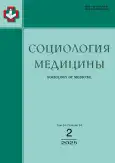Perception of telemedicine by patients and physicians as a mode of interaction in the provision of medical care
- Authors: Romanova T.E.1
-
Affiliations:
- Privolzhsky Research Medical University
- Issue: Vol 24, No 2 (2025)
- Pages: 102-107
- Section: MEDICAL SOCIOLOGICAL STUDIES
- URL: https://rjsocmed.com/1728-2810/article/view/646213
- DOI: https://doi.org/10.17816/socm646213
- EDN: https://elibrary.ru/LLFGNQ
- ID: 646213
Cite item
Abstract
BACKGROUND: The digital transformation of healthcare is a strategic direction of sectoral development. At the same time, issues related to the provision of medical care under the new conditions of a virtual model, as well as the the behavioral features of patients and physicians in the process of providing medical services using remote technologies, remain relevant for study.
AIM: The work aimed to assess the perception of telemedicine by patients and physicians residing in urban and rural areas as a mode of their interaction in the provision of medical care.
METHODS: The study was conducted in medical organizations of the Nizhny Novgorod Region using author-designed questionnaires administered to patients and physicians. A total of 507 patients and 202 physicians participated in the study.
RESULTS: Most patients in all groups were willing to interact remotely with a physician during medical care and believed that telemedicine consultations should develop both in the “physician–patient” and “physician–physician” formats. However, 31.1% ± 4.9% of patients in an urban hospital and 25.0% ± 3.0% of patients in a central district hospital considered telemedicine consultations possible only in the physician–physician format. Among parents bringing children to pediatric outpatient clinics, this proportion was significantly lower—15.8% ± 2.7%.
Similar to the patients, more than half of physicians (57.8% ± 3.5%) believed that telemedicine consultations should develop both in the physician–patient and physician–physician formats. At the same time, only 5.0% ± 1.5% of physicians considered the physician–patient format a priority, whereas 27.4% ± 2.0% of patients shared this view. The χ2 test showed an age-related effect on the perception of telemedicine in both patients (χ2 = 18.452; p = 5.196 × 10⁻³) and physicians (χ2 = 13.804; p = 0.03191).
CONCLUSION: The findings confirm the readiness of both patients and physicians, regardless of place of residence, to use telemedicine. However, age should be taken into account when implementing telemedicine. Respondents aged 60 years and older expressed greater willingness for digital visits compared with those aged 40–59 years.
Full Text
About the authors
Tatyana E. Romanova
Privolzhsky Research Medical University
Author for correspondence.
Email: romanova_te@mail.ru
ORCID iD: 0000-0001-6328-079X
SPIN-code: 4943-6121
MD, Cand. Sci. (Medicine), Assistant Professor
Russian Federation, Nizhny NovgorodReferences
- Vladzymyrskyy AV. The first 150 years of a telemedicine history. Russian Journal of Telemedicine and E-Health. 2015;1(1):10–16. EDN: YSHPJP
- Jiang S, Liu PL, Chia CWJ. Can online patient-provider communication improve emotional well-being? Examining the roles of social presence and patient empowerment. Cyberpsychol Behav Soc Netw. 2023;26(5):366–370. doi: 10.1089/cyber.2022.0289 EDN: EMLUTI
- Bereznoy AV, Saygitov RT. Digital revolution and innovative business models in healthcare: global trends and Russian realities. Annals of the Russian Academy of Medical Sciences. 2016;71(3):200–213. doi: 10.15690/vramn682 EDN: WCZICP
- Cheung L, Leung TI, Ding VY, et al. Healthcare service utilization under a new virtual primary care delivery model. Telemed J E Health. 2019;25(7):551–559. doi: 10.1089/tmj.2018.0145
- Reshetnikov AV, Romanova TE, Abaeva OP, et al. The effect of COVID-19 pandemic on attitude of internet-space surfers to professional activity of physicians in Russia. Problems of social hygiene, public health and history of medicine. 2023;31(3):324–328. doi: 10.32687/0869-866X-2023-31-3-324-328 EDN: TBMIYV
- Zingerman BV, Shklovsky-Kordi NE, Vorobiev AI. About telemedicine «patient to doctor». Medical Doctor and IT. 2017;(1):61–79. EDN: XXJBTJ
- Liu PL, Yeo TED. How online patient-provider communication impacts quality of life: examining the role of patient-centered care and health competence. Health Commun. 2023;38(3):562–567. doi: 10.1080/10410236.2021.1961971 EDN: NZJEVZ
- Grīnfelde M. Face-to-face with the doctor online: phenomenological analysis of patient experience of teleconsultation. Hum Stud. 2022;45(4):673–696. doi: 10.1007/s10746-022-09652-4 EDN: QEIADE
- Bogomiagkova ES, Orekh EA, Glukhova ME. Telemedicine in Russian megacities: problems and prospects. Sociological Journal. 2023;29(3):29–48. doi: 10.19181/socjour.2023.29.3.2 EDN: CGWRRI
- Zaikov A. Telemedicine does not replace a real visit to the doctor… Chelovek.RU. 2022;(17):182–190. doi: 10.32691/2410-0935-2022-17-182-190 EDN: MGZJOY
- Osmanov EM, Reshetnikov VA, Guseinova ZG, Omarov MA. Digital technologies in medicine: opinion of patients with arterial hypertension. Current problems of health care and medical statistics. 2024;(1):909–925. doi: 10.24412/2312-2935-2024-1-909-925 EDN: FBAOZO
- Xu W, Pan Z, Lu S, Zhang L. Regional heterogeneity of application and effect of telemedicine in the primary care centres in rural China. Int J Environ Res Public Health. 2020;17(12):4531. doi: 10.3390/ijerph17124531 EDN: APUVIX
- Rodgers M, Raine G, Thomas S, et al. Informing NHS policy in ‘digital-first primary care’: a rapid evidence synthesis. Southampton (UK): NIHR Journals Library; 2019. doi: 10.3310/hsdr07410
- Ryskina KL, Shultz K, Zhou Y, et al. Older adults' access to primary care: gender, racial, and ethnic disparities in telemedicine. J Am Geriatr Soc. 2021;69(10):2732–2740. doi: 10.1111/jgs.17354 EDN: BPDOXS
- de Man G, Moroz I, Mercer J, et al. Primary care clinician adherence to specialist advice in electronic consultation. Ann Fam Med. 2019;17(2):150–157. doi: 10.1370/afm.2355
- Urbonas T, Lakha AS, King E, et al. The safety of telemedicine clinics as an alternative to in-person preoperative assessment for elective laparoscopic cholecystectomy in patients with benign gallbladder disease: a retrospective cohort study. Patient Saf Surg. 2023;17(1):23. doi: 10.1186/s13037-023-00368-7 EDN: MPZAKW
Supplementary files






